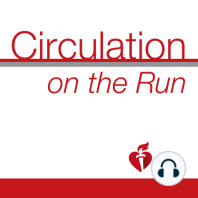16 min listen
Circulation April 14, 2020 Issue
ratings:
Length:
21 minutes
Released:
Apr 13, 2020
Format:
Podcast episode
Description
Dr Carolyn Lam: Welcome to Circulation on the Run, your weekly podcast summary and backstage pass to the journal and its editors. I'm Dr Carolyn Lam, associate editor from the National Heart Center and Duke National University of Singapore. Dr Greg Hundley: I'm Greg Hundley, associate editor from the VCU Pauley Heart Center in Richmond, Virginia. Dr Carolyn Lam: Greg, amyloid cardiomyopathy is the rage. I cannot tell you the number of discussions I've had on the topic. Of course, it was tafamidis, the amazing results with that trial that really made us realize we need to pick this up. But have you ever thought about the cost effectiveness of tafamidis for amyloid cardiomyopathy? Well, guess what? We're going to have a whole feature discussion just about that. But first let's go to our summary, shall we? Dr Greg Hundley: You bet, Carolyn. Well, let me get started. I'm going to talk about regulation of cell cycle growth as well as division in regard to cardiac regeneration. My first paper comes from Dr Lior Zangi from the Mount Sinai School of Medicine. Well, Carolyn, have you ever wondered why the adult mammalian heart has limited regenerative capacity? Dr Carolyn Lam: All the time, Greg. Dr Greg Hundley: Well, of course you have. It's mostly due to postnatal cardiomyocyte cell cycle arrest. In this study the investigators evaluated the effect of pyruvate kinase muscle isozyme 2 and cardiomyocytes through models of loss, that is cardiomyocyte specific PKM2 deletion during cardiac development or gain using cardiomyocytes specific PKM to modified mRNA to evaluate PKM to function and regenerative effects post-acute or chronic MI in mice. Dr Carolyn Lam: Nicely described. What did they find, Greg? Dr Greg Hundley: What they found is that PKM2 is expressed in cardiomyocytes during development and immediately after birth, but not during adulthood. Using cardiomyocytes PKM to modified RNA, they found that cardiomyocyte targeted strategy following acute or chronic MI resulted in increased cardiomyocyte cell division, enhanced cardiac function, and improved long-term survival. They found that PKM2 regulates the cardiomyocyte cell cycle and reduces oxidative stress damage through anabolic pathways and beta-catenin. Dr Carolyn Lam: Cool, Greg. Man, this cardiac regeneration really, really is a hot area. Dr Greg Hundley: Carolyn, that is so insightful because these results really impact research toward unlocking pathways that could be involved in induction of myocyte cell division and regeneration in those sustaining MI or conditions like MI. Dr Carolyn Lam: Nice. Well, Greg, I'm going to change tones here and ask you, can we prevent atrial fibrillation with treatments for diabetes? Well, guess what? We have a paper next. It's from Dr Wiviott from the TIMI Study Group and his colleagues who really reason that since atrial fibrillation is associated with hypertension, obesity and heart failure in patients with diabetes and SGLT2 inhibitors have been shown to lower blood pressure, reduce weight, and reduce hospitalization for heart failure in these patients, perhaps SGLT2 inhibitors may also reduce the risk of atrial fibrillation. They explored the effect of Dapagliflozin on the first and total number of atrial fibrillation and atrial flutter events in patients from the DECLARE-TIMI 58. As a reminder, they had type two diabetes with either multiple risk factors for or known atherosclerotic cardiovascular disease. Now importantly, atrial fibrillation events were identified by a search of the safety database using these MedDAR preferred terms. Now what they found was Dapagliflozin reduced the risk of atrial fibrillation events during follow-up as well as the total number of atrial fibrillation events in patients with type two diabetes. These reductions were consistent across major subgroups including sex, presence of atherosclerotic cardiovascular disease, history of atrial fibrillation, history of heart failure, history of ischemic stroke, HB
Released:
Apr 13, 2020
Format:
Podcast episode
Titles in the series (100)
Circulation August 30, 2016 Issue: Circulation Weekly: Your Weekly Summary & Backstage Pass To The Journal by Circulation on the Run
